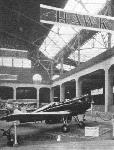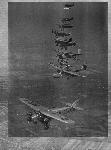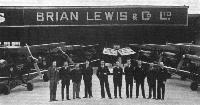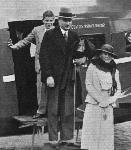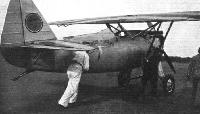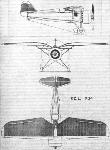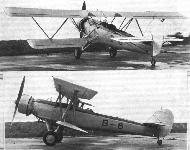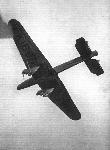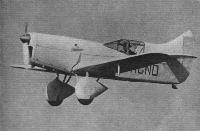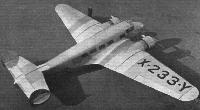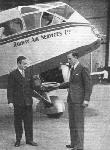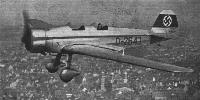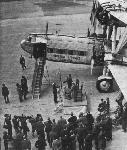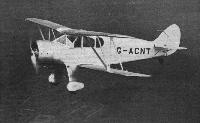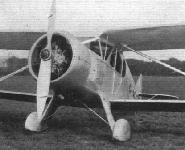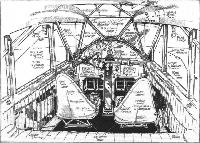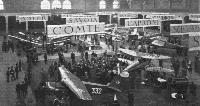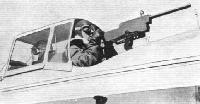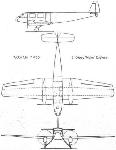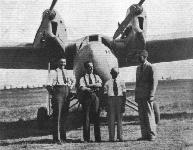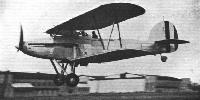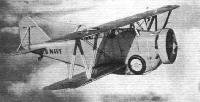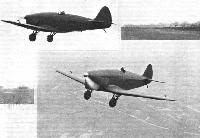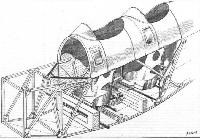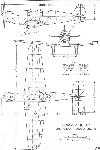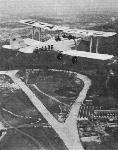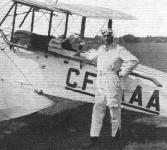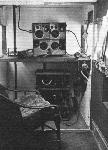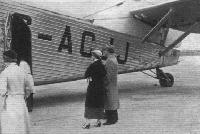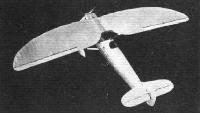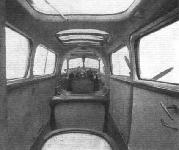Фотографии
-
CLEANED UP: An experimental Curtiss "Goshawk" (F-11C) fighter, with a retractable undercarriage, fitted with a "Cyclone."
Самолёты на фотографии: Curtiss F11C-3 / Hawk III / BF2C-1 / Model 68 - США - 1933
-
UNBALANCED FORCES? A Junkers Ju. 52/3 m. with two Townend rings and one N.A.C.A. cowling on the port side. This type is used for the night service to Berlin.
Самолёты на фотографии: Junkers Ju.52/3m - Германия - 1931
-
GLANZEND: Its low price as well as its remarkably fine finish and ruggedness of construction caused a stream of visitors to the "Hawk" Stand.
Самолёты на фотографии: Miles Hawk / M.2 - Великобритания - 1932
-
Регистрационный номер: G-ACJA UN COIN ANGLAIS: In the foreground the de Havilland Aircraft Co. are together with their agent showing three types of aeroplane. On the left is the Miles "Hawk," and on the right can be seen Herr Schwabe's "Klemm" in which he has recently returned from a flight to Capetown.
Самолёты на фотографии: De Havilland Tiger Moth / D.H.82 - Великобритания - 1931Klemm Kl.32 / Kl.36 - Германия - 1932Miles Hawk / M.2 - Великобритания - 1932
-
STRAIGHT FROM THE NEST: A batch of Miles "Hawks" recently supplied by Phillips fit Powis Aircraft (Reading), Ltd., to Lord Clive, Messrs. Grover, E. D. Spratt, and H. Singh Uberoi.
Самолёты на фотографии: Miles Hawk / M.2 - Великобритания - 1932
-
Регистрационный номер: G-ABBY, G-ACDR The staggering formation of aircraft was flown by instructors of Air Training Services Ltd in 1934. The aircraft are, from top to bottom: Avro Avian IVM, Avro Cadet, Avro Tutor, D.H.9J, Avro 626, Armstrong Whitworth Siskin III, Armstrong Whitworth Atlas, Saro Cutty Sark and an Avro Five.
Самолёты на фотографии: Armstrong Whitworth Atlas / Ajax - Великобритания - 1925Armstrong Whitworth Siskin - Великобритания - 1921Avro Avian / Type 594/616 - Великобритания - 1926Avro Cadet / Type 631/643 - Великобритания - 1932Avro Five / Type 619 / Six / Type 624 - Великобритания - 1929Avro Tutor/Sea Tutor/Prefect / Type 621/646/626 - Великобритания - 1929De Havilland D.H.9J - Великобритания - 1926Saunders-Roe Cutty Sark / A.17 - Великобритания - 1929
-
FROM ANCIENT TO ULTRA-MODERN: The Midland Club takes "official" delivery of its new "Moth Majors" and hands over the historic "Cirrus Moths." "LT," with wings folded, is probably the oldest "Moth" in the country.
Самолёты на фотографии: De Havilland Moth / D.H.60 - Великобритания - 1925De Havilland Moth Major / D.H.60GIII - Великобритания - 1932
-
Регистрационный номер: F-AJTP THE WINNER - ONLY JUST! The Morane Saulnier flown by Detroyat in the Aerobatics Contest.
Самолёты на фотографии: Morane-Saulnier MS.230 - Франция - 1929
-
AN AUTOGIRO FOR INDIA: Raj Kumar Shri Ghanshyamsinhji of Limdi, who is at present taking his British "A" pilot's licence on the Autogiro at Hanworth. He has placed an order for a C.30-type Autogiro, which he intends taking back with him to India, where he already holds the Indian "A" licence.
Самолёты на фотографии: Cierva/Avro C.19 - Великобритания - 1929
-
MONSIEUR LE PRESIDENT: M. Pilet-Golaz, the President of Switzerland, arriving with his family at Geneva in the Curtiss "Condor" of the Swissair Co.
Самолёты на фотографии: Curtiss Condor 18 - США - 1929
-
DAY AND NIGHT: Two interior views of the Curtiss-Wright "Condor" airliner, showing the convertible sleeping berth arrangement, which forms a feature of the new fleet of machines to be put into operation by American Airways between Dallas and Los Angeles.
Самолёты на фотографии: Curtiss Condor 18 - США - 1929
-
THE RUNNER-UP: Doret's Dewoitine D.27 takes the field.
Самолёты на фотографии: Dewoitine D.26 / D.27 / D.53 - Франция - 1928
-
The P.Z.L. P.24 high-wing monoplane (770-h.p. Gnome-Rhone engine).
Самолёты на фотографии: PZL P.24 - Польша - 1933
-
P.Z.L. P.24
Самолёты на фотографии: PZL P.24 - Польша - 1933
-
ALTITUDE RECORD FOR GREAT BRITAIN: The Westland "Wapiti" (Bristol "Phoenix" compression-ignition engine), in which Mr. H. J. Penrose attained a height of nearly 28,000 ft.
Самолёты на фотографии: Westland Wapiti - Великобритания - 1927
-
Самолёты на фотографии: Blackburn Shark / B-6 - Великобритания - 1933
-
Самолёты на фотографии: Blackburn Shark / B-6 - Великобритания - 1933
-
Регистрационный номер: G-ABCJ A Saro "Cloud" fitted with two Napier "Rapier" engines. These engines, having 16 cylinders arranged in four rows of four each and are air-cooled, develop 340 h.p. As an amphibian the "Cloud" carries 8 passengers, with a duration of either 4 hours or 5 1/2 hours. The cruising speed is just over 100 m.p.h.
Самолёты на фотографии: Saunders-Roe Cloud / A.19 - Великобритания - 1930
-
Регистрационный номер: K3560 FOR OPEN SEA RECONNAISSANCE: The SARO A.27 flying boat is fitted with two Bristol "Pegasus" engines.
Самолёты на фотографии: Saunders-Roe London / A.27 - Великобритания - 1934
-
AMPHIBIOUS: This is a drawing of the Fairchild amphibian flying boat, one of the variety of types ordered by Pan-American Airways with a view to a big speeding up of their services.
Самолёты на фотографии: Grumman G-21/JRF/OA-9/OA-13 Goose - США - 1937
-
Регистрационный номер: G-ABIS, HM505 INVERSION: An Avro Tutor from A.S.T. over Southampton Water. The attitude of the sailing vessel is sufficient proof that the picture itself has not been inverted!
Самолёты на фотографии: Avro Tutor/Sea Tutor/Prefect / Type 621/646/626 - Великобритания - 1929
-
Регистрационный номер: K2570 FOR NAVIGATIONAL TRAINING: A D.H. "Tiger Moth" fitted with a hood for instruction in the art of "blind flying." As previously recorded in FLIGHT, a number of "Tiger Moths" so equipped have been ordered for the Royal Air Force. The particular machine illustrated belongs to No. 24 (Communications) Squadron.
Самолёты на фотографии: De Havilland Tiger Moth / D.H.82 - Великобритания - 1931
-
Регистрационный номер: K1695 THE FAIREY NIGHT BOMBER: In spite of its 8 1/2 - 9 tons, Mr. C. Staniland, Fairey's Chief Test Pilot, "throws it about" in an amazing fashion. The engines are Rolls-Royce "Kestrel" III.S, which develop 480 b.h.p. at 11 000 ft. Note the rounded triangle section of the fuselage, which enables the gunner to fire downwards.
Further view of the prototype Hendon. The triangular fuselage section aft of the wings is seen to good effect in the photograph.Самолёты на фотографии: Fairey Hendon - Великобритания - 1930
-
Регистрационный номер: G-ACND PRINCE GEORGES ENTRY: The Percival "Mew Gull" which will be flown by Mr. Percival in the King's Cup Race.
Самолёты на фотографии: Percival Mew Gull - Великобритания - 1934
-
THE MAILLET-NENING: The engine is a 6-cyl. Regnier.
Самолёты на фотографии: SFCA Maillet 20 - Франция - 1935
-
Регистрационный номер: D-2911, D-2984 The visiting machines on the tarmac at Heston.
Самолёты на фотографии: Focke-Wulf FW.44 Steiglitz - Германия - 1932
-
Регистрационный номер: D-2495 [L.28] A FAIR WINNER: Miss Liesel Bach, of Germany, who won the International Feminine Cup in her Klemm monoplane.
Самолёты на фотографии: Klemm L.25 - L.28 Swallow - Германия - 1927
-
Регистрационный номер: NC499N THE "BEECHCRAFT": A later and smaller version than that shown is fitted with a retractable undercarriage.
Самолёты на фотографии: Beechcraft Model 17 Staggerwing - США - 1932
-
Самолёты на фотографии: Beechcraft Model 17 Staggerwing - США - 1932
-
Регистрационный номер: X233Y A SPEEDY EXAMPLE: The Lockheed "Electra," operated by certain American airlines, has a top speed of about 220 m.p.h. Although, compared with other types, the accommodation is somewhat cramped, the cabin is by no means uncomfortable.
Самолёты на фотографии: Lockheed Electra 10 - США - 1934
-
Security "Airster"
Самолёты на фотографии: Security S-1 Airster - США - 1933
-
Регистрационный номер: NC13834 THE STINSON "RELIANT": This is the 1934 model, which, powered with the Lycoming 225 h.p. engine, carries four passengers in an unusually comfortable cabin. The basic design is similar to that of previous Stinson machines, examples of which have been seen in this country. The cruising speed is 115 m.p.h.
Самолёты на фотографии: Stinson Reliant - США - 1933
-
Регистрационный номер: G-ACPX SECOND R.A.S. STARTS: Last week the first of the D.H. "Dragons" - shown in the illustration was delivered to Imperial Airways on behalf of Railway Air Services for operation on the Plymouth Liverpool route.
Самолёты на фотографии: De Havilland Dragon / D.H.84 - Великобритания - 1932
-
SECOND R.A.S. STARTS: Maj. Brackley, of Imperial Airways (left), is seen receiving the log-books, etc., of the machine.
Самолёты на фотографии: De Havilland Dragon / D.H.84 - Великобритания - 1932
-
Регистрационный номер: D-2643 DEUTSCHE SCHONHEIT: The Messerschmitt 35 is very clean and has a fine performance. The Swastika leaves no doubt as to its country of origin.
Самолёты на фотографии: Messerschmitt BFW M.35 - Германия - 1933
-
Регистрационный номер: G-AAXE THE ROYAL AIR MAIL: Sir Kingsley Wood, the Postmaster-General, presents the first Royal Air Mail Pennant to Sir Eric Geddes, who hands it over to Capt. H. J. Horsey of the good ship Hengist.
Самолёты на фотографии: Handley Page H.P.42 / H.P.45 - Великобритания - 1930
-
Регистрационный номер: K3488 Transparent wind screens have been used with good results on a Westland "Wallace." Both pilot's and gunner's coupes can be either fully closed or fully open, according to the conditions encountered. The gunner's hood, when closed, still leaves him complete freedom for bombing, wireless, etc.
Самолёты на фотографии: Westland Wallace / PV.3 / PV.6 - Великобритания - 1931
-
Регистрационный номер: G-ACLT, X9394 CHAPTER II: Loading up the two Airspeed "Couriers" at Hanworth before their journey to Manchester.
Самолёты на фотографии: Airspeed Courier / AS.5 - Великобритания - 1933
-
Mureaux Type 170 C1
Самолёты на фотографии: ANF Mureaux Mureaux 170 - Франция - 1932
-
THE FIRST AVRO ENCLOSED BIPLANE: This machine, fitted with a 100-h.p. Green 4-cylinder water-cooled engine, was entered in the Military Trials, Salisbury Plain, in 1912.
Самолёты на фотографии: Avro Type G - Великобритания - 1912
-
Регистрационный номер: G-ACNT [5] COMFORTABLE TRAVEL: The Avro "Commodore" ("Lynx" engine).
Самолёты на фотографии: Avro Commodore / Type 641 - Великобритания - 1934
-
Регистрационный номер: G-ACNT [5] FOR COMFORT AND SOLIDITY: Spectacular performance has not been sought in the design of this Lynx-engined Avro. The machine is a 4-5 seater with dual control, and is finished and upholstered in a style comparable with that of a high-class motor car.
Самолёты на фотографии: Avro Commodore / Type 641 - Великобритания - 1934
-
Регистрационный номер: G-ACNT [5] THE AVRO "COMMODORE": The undercarriage is semi-cantilever, and the wing bracing consists of a single lift wire and a single anti-lift strut.
Самолёты на фотографии: Avro Commodore / Type 641 - Великобритания - 1934
-
Регистрационный номер: G-ACNT [5] THE BUSINESS END: The Siddeley "Lynx" is enclosed in a N.A.C.A. cowling. An electric starter is fitted.
Самолёты на фотографии: Avro Commodore / Type 641 - Великобритания - 1934
-
Регистрационный номер: G-ACNT [5] THE AVRO "COMMODORE": Ailerons are fitted on the lower wing only, where they are readily accessible for adjustment.
Самолёты на фотографии: Avro Commodore / Type 641 - Великобритания - 1934
-
THE CABIN ARRANGEMENT: Plenty of room everywhere, and a good view in all essential directions are the outstanding features. The instrument board lay-out is unusual.
Самолёты на фотографии: Avro Commodore / Type 641 - Великобритания - 1934
-
The larger sketch shows the arrangement of the main fuselage and wing structure members, while the smaller sketches illustrate some of the details.
Самолёты на фотографии: Avro Commodore / Type 641 - Великобритания - 1934
-
Avro 641 215 hp. Siddeley "Lynx" Engine
Самолёты на фотографии: Avro Commodore / Type 641 - Великобритания - 1934
-
Регистрационный номер: G-ABHO [2] BUSY B.A.N.C.O.: Last Saturday the British Air Navigation Co.'s Tri-motor Ford, Voyager, was pressed into service between Heston and Jersey to transport an "overflow" load of nine passengers from the regular service. Here we see the passengers emplaning at Heston.
Самолёты на фотографии: Ford Tri-Motor / 4-AT / 5-AT - США - 1926
-
Регистрационный номер: G-ABHO [2] A LARGE VISITOR AT JERSEY: Last week we illustrated the British Air Navigation Co.'s Tri-motor Ford, Voyager, at Heston prior to its departure for Jersey. This picture was taken on the sands at Jersey after its arrival.
Самолёты на фотографии: Ford Tri-Motor / 4-AT / 5-AT - США - 1926
-
FOR NAVAL OBSERVATION: The B/J OJ-2, shown here fitted with a "Wasp Junior" engine.
Самолёты на фотографии: Berliner-Joyce OJ - США - 1931
-
B/J OJ-1
Самолёты на фотографии: Berliner-Joyce OJ - США - 1931
-
HOOKED! There is a certain grotesquely helpless appearance about this aircraftsman as he is jerked off the wing of the Vickers "Virginia" during practice near Henlow.
Самолёты на фотографии: Vickers Virginia - Великобритания - 1922
-
Lord Lonsdale with Councillor E. Wilburn examining the Shell-Mex & B.P. Co.'s Comper "Swift" (Pobjoy) after the opening of the Doncaster airport.
Самолёты на фотографии: Comper Swift / CLA.7 - Великобритания - 1930
-
Регистрационный номер: CH-332, I-ABMB LA OUVERTURE OFFICIELLE: In this view the Swiss President is examining the Caproni biplane. In the foreground is the Comte aeroplane, a Swiss production.
Самолёты на фотографии: Caproni Ca.125 - Италия - 1933Comte AC-4 Gentleman / AC-8 / AC-12 Moskito - Швейцария - 1927
-
The Fairchild camera gun installed in the Curtiss "Falcon."
Самолёты на фотографии: Curtiss F8C Falcon / Helldiver - США - 1928
-
Регистрационный номер: F-AMRM AVION DE TOURISME: The Lorraine engine on the nose of the Farman 402 looks somewhat large, but gives this three-seater cabin machine a fairly good performance.
Самолёты на фотографии: Farman F.400 - Франция - 1933
-
Farman F.430 2 Gipsy "Major" Engines.
Самолёты на фотографии: Farman F.430 - Франция - 1934
-
ALL-AUSTRALIAN: On March 6 successful first trial flights of Sir Charles Kingsford Smith's Australian-built monoplane, the "Codock" (Napier "Javelin" engines), were carried out at Mascot Aerodrome. Here we see a portion of the "Codock," with (from left to right) Wing Commander Wackett (designer and builder), Sir Charles Kingsford Smith, Sqd. Ldr. (Tiny) White (who will fly the machine to New Zealand), and Mr. M. P. Allsopp (Aviation Representative of the Vacuum Oil Co., Pty., Ltd.). Plume and Mobiloil Aero W. were used during the test flights.
Самолёты на фотографии: Cockatoo Dockyard & Engineering Co LJW-6 Codock - Австралия - 1933
-
Gloster TSR.38 участвовал в тендере с прототипом фирмы "Fairey", на основе которого впоследствии создали знаменитый торпедоносец-бомбардировщик Fairey Swordfish.
A FLEET T.S.R.: The letters represent Torpedo-carrying, Fleet-spotting, and Reconnaissance, and the machine is a product of the Gloster company. The engine is a Rolls-Royce experimental.Самолёты на фотографии: Gloster FS.36 / TSR.38 - Великобритания - 1932
-
CLEANED UP: The Grumman FF-1 two-seater fighter with retractable undercarriage and Wright "Cyclone F" engine
Самолёты на фотографии: Grumman FF / SF / Goblin - США - 1931
-
THE POTEZ 41: The top speed of this all-metal machine is 198 m.p.h. at 13,000 ft., and it is claimed, with its four 850 h.p. Hispano-Suiza engines, to be the most powerful bombing machine in France.
Самолёты на фотографии: Potez Potez 41 - Франция - 1934
-
Регистрационный номер: D-3224 ANGLICISED: One of the machines brought over by the week-end party, a Heinkel "Kadett," has a distinctly "English" look.
Самолёты на фотографии: Heinkel He-72 Kadett - Германия - 1933
-
M. Manchoulas coming in to land at Le Bourget after his flight from Ghent in the Scorpion-engined power glider.
Самолёты на фотографии: Kronfeld Drone - Великобритания - 1932
-
Самолёты на фотографии: Comper Streak / Kite - Великобритания - 1934
-
THE COMPER "STREAK": In a recent issue of "Flight" we reported that a certain amount of aileron flutter had arisen. By giving ailerons a very narrow chord and fitting mass-balances, as indicated by the illustration, the trouble has completely disappeared.
Самолёты на фотографии: Comper Streak / Kite - Великобритания - 1934
-
A COMPOSITE PICTURE: Showing how the "Kite" will look when flying.
Самолёты на фотографии: Comper Streak / Kite - Великобритания - 1934
-
NEW SEATING ARRANGEMENT: The additional bay to carry the new engine mounting for the Pobjoy "Niagara" is also shown.
Самолёты на фотографии: Comper Streak / Kite - Великобритания - 1934
-
Comper "Kite" 90 hp Pobjoy "Niagara" Engine
Самолёты на фотографии: Comper Streak / Kite - Великобритания - 1934
-
Регистрационный номер: F-AMRA AVEC "BEC DE SECURITE": This French cabin machine, a Potez 58, is fitted with permanently open "slots," and has very comfortable seating accommodation for three persons.
Самолёты на фотографии: Potez Potez 43 / 58 - Франция - 1932
-
OVER NEW YORK: Major Alexander P. de Seversky flies his latest type, which may yet be entered for the "MacRobertson."
Самолёты на фотографии: Seversky SEV-3 - США - 1933
-
Регистрационный номер: G-AAAA CAN I LAND HERE? The machine is banking low in order to see if the ground is suitable for landing.
Самолёты на фотографии: De Havilland Gipsy Moth / Moth X - Великобритания - 1928
-
Регистрационный номер: G-AARB Miss Jean Batten flying over Brooklands in her "Moth."
Самолёты на фотографии: De Havilland Gipsy Moth / Moth X - Великобритания - 1928
-
Регистрационный номер: CF-AAA THE "HIGH" COMMISSIONER: Maj. Gen. James H. MacBrien, Commissioner of Royal Canadian Mounted Police, who employs aircraft to some considerable extent in his duties.
Самолёты на фотографии: De Havilland Gipsy Moth / Moth X - Великобритания - 1928
-
A FLAT TURN: A "Moth" shows how not to turn near an enclosure.
Самолёты на фотографии: De Havilland Gipsy Moth / Moth X - Великобритания - 1928
-
The equipment fitted in the Avro Five used by Air Service Training for wireless instruction.
Самолёты на фотографии: Avro Five / Type 619 / Six / Type 624 - Великобритания - 1929
-
DOGGED BY ILL LUCK: The two Potez machines entered were unfortunate, one having to land with a broken oil pipe, and the other being put out of the race by his "two-step" propeller insisting on remaining in the high-pitch position for the take-off.
Самолёты на фотографии: Potez Potez 53 - Франция - 1933
-
Регистрационный номер: F-AKDY FOR THE MADAGASCAR SERVICE: The S.P.C.A. 41.T monoplane (three 135-h.p. Salmson 9 N.C. engines) to be used on the new French Madagascar-Broken Hill air line.
Самолёты на фотографии: SPCA Type 40T / 41T - Франция - 1929
-
Регистрационный номер: G-ACJJ Mr. and Mrs. Anthony Fokker on the tarmac at Croydon.
Самолёты на фотографии: Short Scylla / L.17 - Великобритания - 1934
-
"ATALANTE": The Caudron C.366 (Regnier engine) entered by M. Regnier.
Самолёты на фотографии: Caudron C.360 / C.450 / C.460 / C.560 - Франция - 1933
-
TESTED BY DELMOTTE: The Caudron C.450, with 310-h.p. Renault engine.
Самолёты на фотографии: Caudron C.360 / C.450 / C.460 / C.560 - Франция - 1933
-
THE LATEST VERSION: The Caudron C.460 has a retractable undercarriage.
Самолёты на фотографии: Caudron C.360 / C.450 / C.460 / C.560 - Франция - 1933
-
BRINGING IN THE WINNER: The Caudron C.460 is fitted with a supercharged Renault 6-cylinder in-line air-cooled engine of about 310 h.p.
Самолёты на фотографии: Caudron C.360 / C.450 / C.460 / C.560 - Франция - 1933
-
A MONOPLANE FIGHTER: The Dornier Do.C.4, which may be equipped with the Rolls-Royce "Kestrel" or Hispano-Suiza 12X engines.
Самолёты на фотографии: Dornier Do.10 (Do.C4) - Германия - 1931
-
This view of the Dornier Do.C.4 monoplane shows the tapered wings.
Самолёты на фотографии: Dornier Do.10 (Do.C4) - Германия - 1931
-
Регистрационный номер: F-AMTJ [2] A FRENCH TOURING PLANE: The Couzinet cabin monoplane powered with three Pobjoy "R" engines.
Самолёты на фотографии: Couzinet Couzinet 101 - Франция - 1933
-
Регистрационный номер: F-AMTJ [2] An interior view of the cabin of the Couzinet 101 monoplane.
Самолёты на фотографии: Couzinet Couzinet 101 - Франция - 1933
Статьи
- Flight


